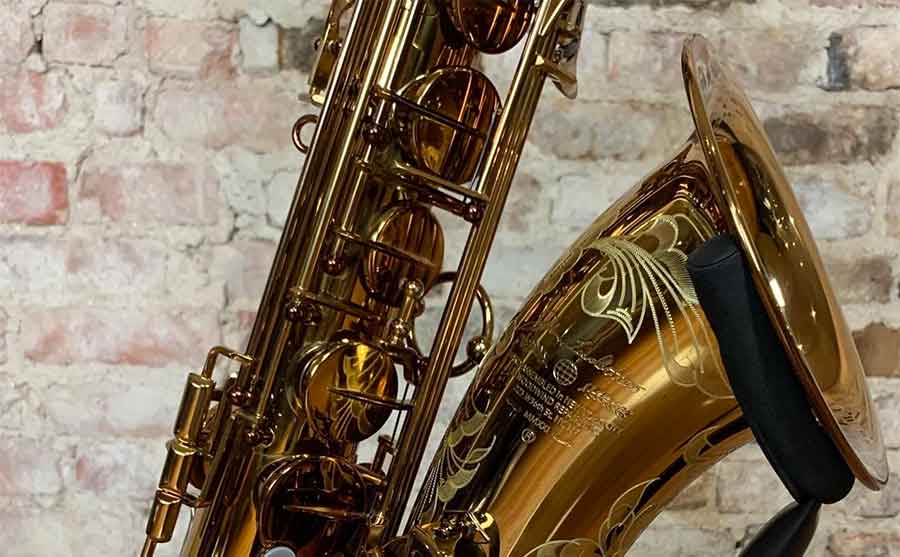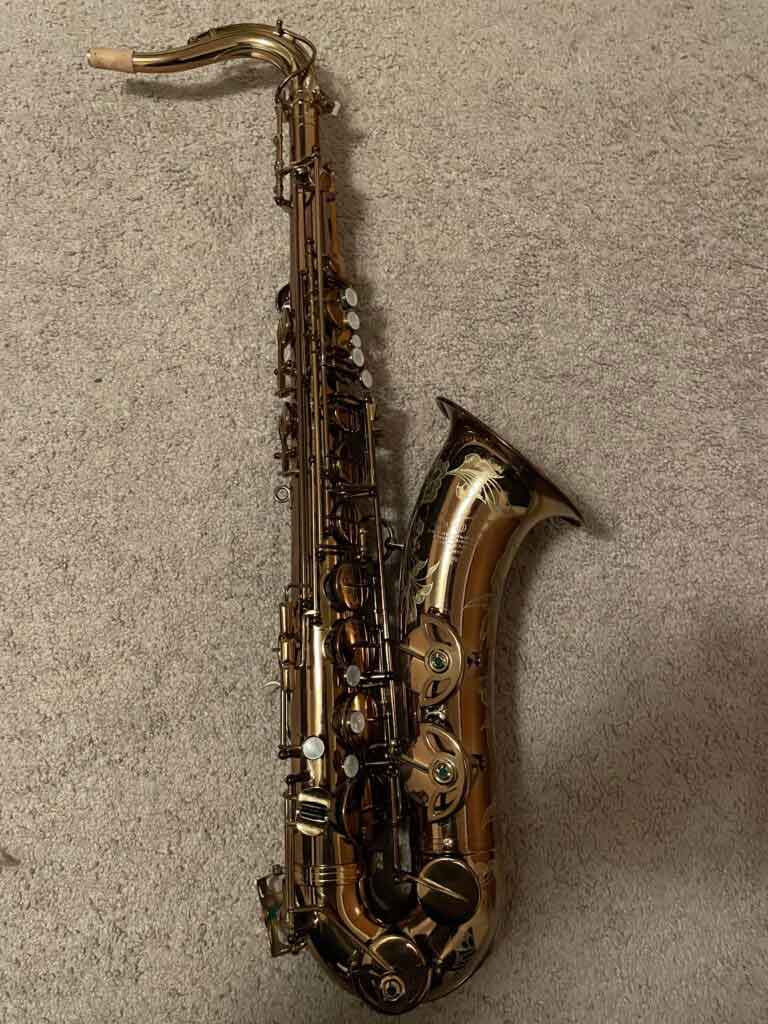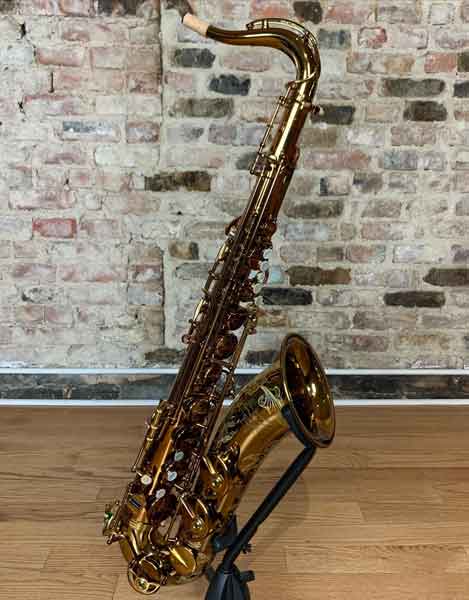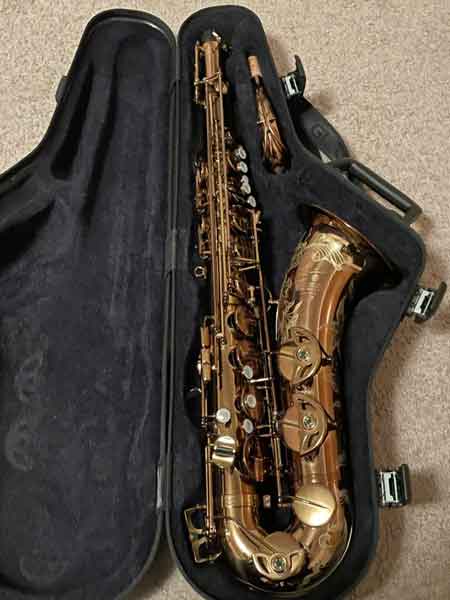Review of JL Woodwinds Artist Edition New York Signature Tenor Saxophone

Introduction
It’s been over five years since I last visited John’s shop and much has changed since then. Besides having a large assortment of modern and vintage saxophones, John has expanded his line of products to carry Ted Klum’s mouthpieces, Ishimori ligature & reeds, and an assortment of vintage mouthpiece, ligatures and some neck-straps. While at John’s shop, I was able to try quite a few vintage Selmer Mark VI’s, Selmer Super Balanced Action tenors, and an assortment of modern saxophones, from a Yanagisawa TW020 to an Eastman EST850 to finally John’s Artist Edition New York Signature series line of horns which have been updated quite a bit since I tested the first version.
I will be sharing my experience play testing the JL Woodwinds Artist Edition New York Signature tenor saxophone. For those of you that haven’t tried or curious about John’s line of saxophones, what follows is a quick overview.
Overview
When speaking with John, he explained to me the following about his line of saxophone which makes them a bit different from other saxophones that are being manufactured in Taiwan and setup in the U.S. today:
- When speaking with John, he explained to me the following about his line of saxophones, which makes them a bit different from others manufactured in Taiwan and set up in the U.S. today:
- Since the first JL model was released, the Artist Edition saxophones have been the culmination of seven years of experimenting and discovering what makes a saxophone perform, respond, and ultimately play as best as possible.
- Most professional saxophonists and upcoming players will agree that some of the vintage saxophones manufactured by Selmer, Martin, and Conn from the early 1940s through the 1960s were some of the best saxophones ever produced. The quality of craftsmanship and attention to detail was something that is often considered unmatched and not found in many modern saxophones currently manufactured.
- The design and production of The Artist Edition New York Signature Tenors is John’s attempt to address this problem. Since first researching and experimenting with the JL line of saxophones in 2014, John wanted to create a competitively priced and ergonomic modern saxophone with a similar sound, essence, and “vibe” of the vintage Selmer saxophones.
- The JL Artist Edition saxophones are inspired by some of the best playing and sounding early 5 Digit Mark VI Tenors that have come through John’s shop over the years, and the parts for the Artist Edition saxophones are produced to John’s specific specifications in four separate saxophone factories in Taiwan. The body tubes, bell, and necks for the JL saxophones are of proprietary thickness, mirroring the vintage Selmer’s.
- The body tube, tone hole placements, and diameters have been mapped out from the measurements John took from his all-time favorite playing Selmer Super Balanced Action Tenors that came into the shop.
- Some additional adjustments to this body tube and its tone hole placements were made simply to improve the ease of intonation and slotting of pitch when compared to the original SBA Tenor body tubes.
- All of the parts are made with the highest quality S Brass, “silver brass,” which is standard brass that includes 3% silver in the alloy.
- Once these parts arrive at the shop, each Artist Edition saxophone is hand-assembled one by one with the utmost care and attention to the finest details.
- This assembly process requires approximately 15-20 hours to complete from start to finish because during this setup, additional work is required, such as hand-finishing each tone hole so they are perfectly level and completely deburred of any and all sharp edges. Without this work, this could lead over time to cuts in the pad faces resulting in leaks.
- All of the rods on the saxophone are checked for perfect straightness and then run through the key-work one by one to check and correct any and all friction that is present.
- The keys of the Artist Edition Saxophones are precision fit between each post so that the keys have no unnecessary lateral or rotational play.
- This Artist edition saxophone displays a cognac-lacquered finish and ‘Selmer-inspired’ floral engravings down the bell and bottom bow.
- The Artist Edition saxophones during the hand-assembling process are set up with top-quality Pisoni Pro Pads, which are installed with shellac.
Materials & Finish

When I received the Artist Edition tenor and took off the key clamps, I was able to get a better look at the felts, corks, and springs. Compared to other Taiwanese saxophones on the market today, I did find John’s Artist Edition saxophone was installed with quality cork (not squishy but firm) that would hold up, as well as good quality felts and springs. The mother of pearl quality and feel also reminded me of that found on a Yamaha or Yanagisawa.
The JL Artist Edition comes in an array of finishes from unlacquered to cognac to silver-plated to a combination depending on your requests, but typically I see the cognac and unlacquered being the two most popular finishes. The JL Artist Edition model I had was with a cognac finish that was similar to what you may see on various vintage Selmers but a bit brighter and lighter in color.
The engraving on the JL Artist Edition saxophone was a crisp floral engraving that was very similar to the Ishimori Woodstone tenor I saw at the shop, as well as I believe the P. Mauriat 66RUL model.
Setup
The Artist Edition saxophone felt comfortable from low Bb to high F# with standard key heights and quite fluid action. Like many new saxophones, there typically is a break-in process or adjustments can be made to make the key action lighter. I would like to lighten up a little bit of the Artist Edition tenor I test played, but overall the Artist Edition tenor did not feel tight or clunky at all.
The octave key had very short play, so you could move between the octaves quickly. I felt moving around the pinky table was quite easy as well as into the palm keys and altissimo. I will say, the palm keys felt comfortable but after some time playing, I probably would either add cork or epoxy putty to the Eb palm key to make it a little bit easier for my left hand to get around, but this is personal to me. The play between each key was non-existent, which is something you do not find on every saxophone you play, leading to a better playing experience. In terms of the overall setup, the Artist Edition was definitely one of the best horns I played at the shop in comparison to some other modern saxophones made in Taiwan and elsewhere.

Sound
I found the Artist Edition to lean towards a neutral to dark sound. Now, depending on your setup and your overall sound concept, I feel certain players can make a traditional dark setup sound bright and vice versa. With that being said, I found the Artist Edition saxophone had much clarity or core to the sound versus spread, as well as when pushed, you could gain a nice edge to the overall sound. I found the tone for me stayed dark in the low end and mid’s. Once I started playing into the upper stack, I did find that when I pushed more air, the palm keys would brighten up.
After some more playing testing over the past few days, I was able to control this better, and like any saxophone you play test, you need to adjust. I was able to test the JL Artist Edition tenor with the stock neck as well as the Boston Sax Shop Neck, and the neck really does make a difference in terms of how the saxophone responds. I found the JL Artist Edition neck to be a bit more resistant than the Boston Sax Shop neck, which could be due to the angle. With that being said, I think many players will actually like the resistance level (including myself) because it provides you something to push against, which is where I think some of those interesting colors within the sound come from.
Response & Intonation
Even with the neck resistance on the Artist Edition compared to my current setup, the Artist Edition responded quickly from top to bottom and was incredibly easy to sub-tone throughout the entire range of the saxophone. The overall ease of response and consistency across the range was great, and even working through my overtone series, the notes were slotting correctly. I did not notice any specific notes that were excessively flat or sharp. Every note I was able to play in tune with not much adjustment. I think much of this has to do with the overall setup process John puts into each Artist Edition saxophone.
A / B Comparisons
My Own Horn
Noodling & Blues – Lupifaro Tenor
JL Artist Edition NY Signature Tenor
Noodling & Blues
Noodling & Standard’s Changes
Body & Soul Michael Brecker Solo (Attempt)
Final Thoughts
Since playing the Artist Edition tenor when I visited John’s shop as well as having it for a few weeks to play test I am very pleased with what John is trying to offer to the saxophone community. Now, I have spoken to various players who play the artist edition saxophone (Geoff Vidal, Steve Kortyka, Chris Bittner, Troy Roberts) who really enjoy the Artist Edition saxophone and gig with it regularly or will leverage the Artist Edition saxophone for some where it may be too risky to take their vintage horn.
Now, after speaking with John and play testing the Artist Edition saxophone myself, I believe many players will enjoy how this saxophone plays and others will stay with their Mark VI or SBA, and that’s fine. One common theme that came up when speaking to various artists as well as players who have tried the Artist Edition saxophones was either; “I have a Mark VI or SBA saxophone and as I travel more or to certain gigs, sometimes I just don’t want to deal with the headache if something were to happen to my vintage saxophone which is expensive and quite hard to find a replacement”, or “I have been searching for a vintage saxophone but would prefer a modern horn in terms of material longevity as well as modern improvements found on modern saxophones”.
As I mentioned earlier, while at John’s shop, I had the opportunity to try the following tenor’s: two Mark VI’s, one SBA, an Eastman 850 saxophone, a Yanagisawa W020, an Ishimori Woodstone Tenor, and a JL Artist Edition Tenor. Overall I like each horn for various reasons but if I had to make a choice, it would have been between the Mark VI 100,xxx and the JL Artist Edition saxophone.
Sure, if money were no object, then I’d love to own the $13,995 Mark VI I tried. But in terms of most peoples’ financial reality, the JL Artist Edition saxophone, listed at $4,350, is a great choice. If you are looking for a modern “vintage” saxophone, the ones that I would group together from a setup as well as price perspective would be the JL Artist Edition, Ishimori Woodstone, Retro Revival Tru-Six, TM Custom Saxophone, and Remy Saxophones, which range from $3800 – $5,000-ish (price range excludes additional custom work or finish provided).
Now, if after trying each of these saxophones and you decide on a Yanagisawa, Yamaha, Keilwerth, or modern Selmer instead, that is fine as well but what’s nice about John’s shop is for the most part, you have the ability to try a wide assortment of modern and vintage saxophones all in one place.
I would like to thank John for taking the time to send me his JL Woodwinds Artist Edition New York Signature tenor saxophone. Again, if you are currently in the market for a vintage saxophone or new “vintage” saxophone, I highly suggest you take a look at John’s Artist line of saxophones, and if you can actually visit his shop in-person, also check out the many other horns at the shop to gain a better understanding what is available and what suits your playing style best.
- Website: https://www.jlwoodwindrepair.com/
- Social: https://www.instagram.com/jlwoodwinds/







The Extraordinary Journey of Saxophonist Aidan McKeon » Best. Saxophone. Website. Ever.
March 24, 2024 @ 10:21 am
[…] just really important to have good working equipment. I would like to get a modern horn like one of John Leadbetter’s horns as a back-up tenor because I love the Conn, but I need something I can travel with that I […]